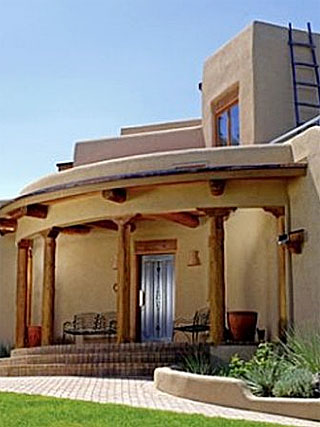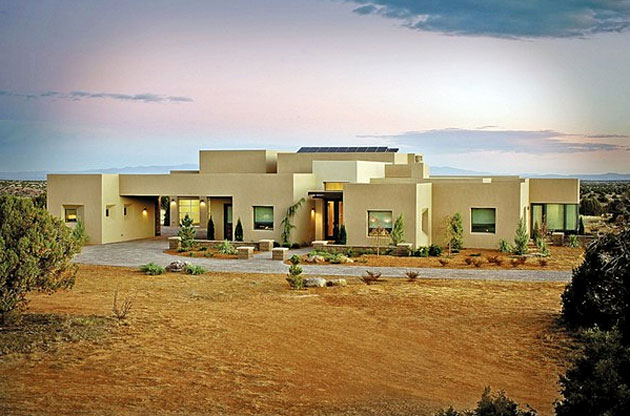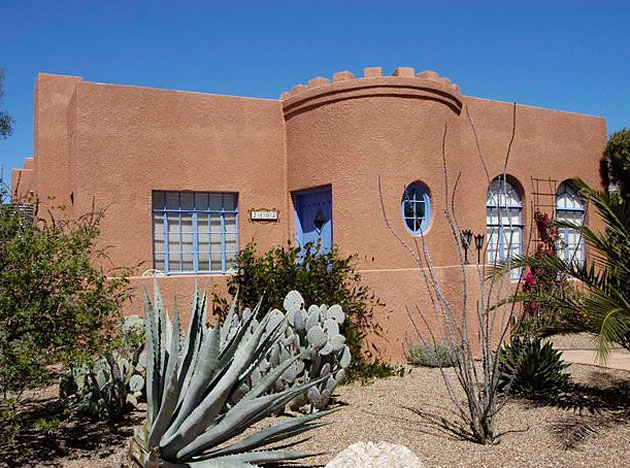Pueblo Homes
Pueblo homes, also sometimes referred to as "adobes"
because of the material from which they are built, take their
inspiration from Native American earthen dwellings that have been
in use for centuries.
 Pueblo Home
Pueblo Home |
|
The main features of pueblo homes include gigantic, rounded
adobe walls, flat roofs that lack overhang, heavy timbers (or
vigas) that extend through the walls to provide roof support,
latillas (or poles) angled above the vigas, rounded parapets that
contain spouts for rain water, simple windows and deep door and
window openings.
The homes also contain bancos (or benches) protruding from the
walls, beehive fireplaces in the corners, nichos (or niches) that
are carved in the walls in order to display religious icons, stepped
levels, and floors made of wood, brick, or flagstones. Pueblo
Revival homes, with their Spanish influence, may also have enclosed
patios, corbels, porches supported by posts and heavy doors made
of wood.
There are variations on
the Pueblo revival style. Contemporary Pueblo is
unornamented, and lacks vigas, posts or beams. Pueblo Deco combines
Art Deco with Pueblo Revival, and is characterized by Native American
designs and geometric patterns. The Territorial Pueblo has square
corners as opposed to rounded, and the window frames are straight
moldings made of wood. The Santa Fe style has become the standard
for New Mexico, following the Santa Fe Historic Zoning Ordinance
in 1957.

Modern Pueblo House
Since ancient times, Pueblo Indians built large, multi-family
houses, which the Spanish called pueblos (villages). In the 17th
and 18th centuries, the Spanish made their own Pueblo homes, but
they adapted the style. They formed the adobe into sun-dried building
blocks. After stacking the blocks, the Spaniards covered them
with protective layers of mud.
Pueblo Revival has been a popular architectural style since the
early 1900s in the southwestern portion of the United States,
and also in California and Florida. In the 1920s, Glenn Curtiss,
the aviation pioneer, partnered with James Bright to create an
entire housing development of buildings made from concrete blocks
or wood frame in the area that is now known as Miami Springs.
Modern Pueblos are frequently
made with blocks of concrete, or from other materials,
and then covered with plaster, mortar, stucco or adobe. This has
its history in the construction methods used by West Texas Indians,
who lacked materials like hides or grasses to cover their houses.
Instead, they had rocks, straw, and dirt, and they used these
materials to make their adobe homes. Adobe is simply straw mixed
with mud and then dried to make bricks.

Pueblo with Desert Landscaping
Having made the bricks, the Pueblo people then stacked them to
construct walls. Gaps were chinked with additional mud to block
the elements and prevent insects and vermin from entering. Each
room had wooden posts to support the roof. The roof was created
by using a layer of sticks covered with grass, then mud, and finished
using plaster.
The Pueblo people also used plaster on their floors and walls.
The floors were then frequently painted in bands of black, yellow,
white and red.
Conclusion
Pueblo architecture, in its many variations, remains popular
to this day.
|

